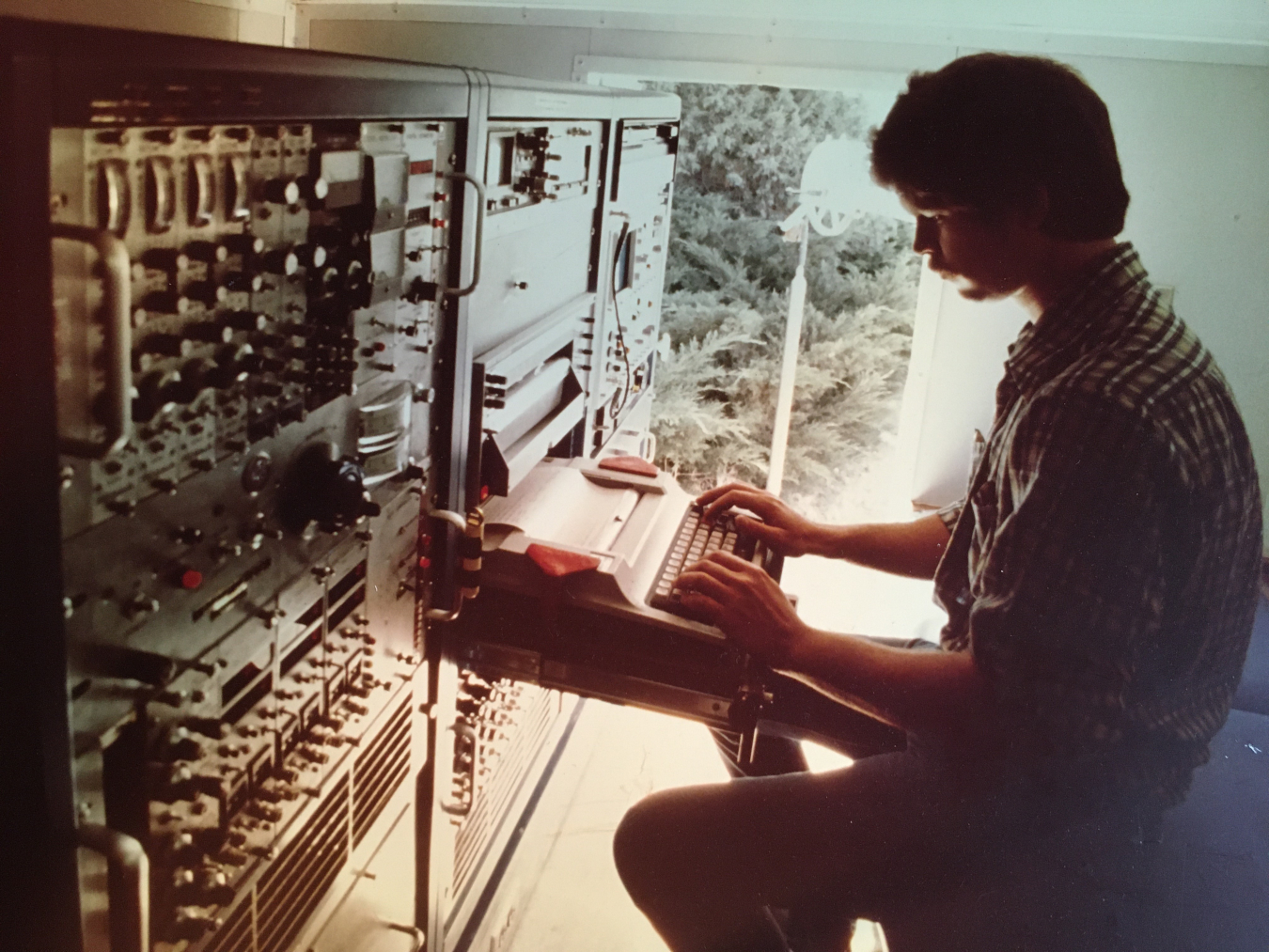After earning degree, geologist knew he didn’t want to live in a big city and chose Grand Junction more or less at random.
May 12, 2022A random finger on a map in 1978 started Dave Traub on a long career and a new hometown.
Traub, most recently the Uranium Mill Tailings Radiation Control Act Title II manager for the Office of Legacy Management (LM) Strategic Partner RSI EnTech, retired in February after working for a succession of U.S. Department of Energy contractors in Grand Junction, Colorado.

Dave Traub operates a “state of the art” semi-processor-based geophysical logging system mounted in a DOE truck in 1980.
Traub said a college ski trip to Winter Park Resort and a Purdue University geology field camp near Walden convinced him he liked Colorado. When he graduated with a degree in geology from Purdue in 1978, he didn’t want to live in a big city.
“So, I opened a map of Colorado, closed my eyes and waved my hand until it came down right on Grand Junction,” he said. “Loaded up the Vega and headed west. Walked into the (Atomic Legacy Cabin) and Bendix Field Engineering was hiring fresh-out geologists.”
Bendix, a DOE contractor at the time, was running the National Uranium Resource Evaluation, or NURE, program out of the DOE Grand Junction facility. The NURE program was initiated by the Atomic Energy Commission (now the DOE) in 1973 with a primary goal of identifying uranium resources in the United States. The program would sample soil, rock, groundwater and collect geophysical data to determine the extent of the nation’s uranium reserves.
“They asked if I’d ever driven 4-wheel-drive vehicles before,” he said. “I figured driving my friend’s Blazer to a liquor store in August counted as a yes and I started out in the geophysical logging group for the NURE program. I ended up traveling all over the country under that contract.”
Some of his favorite jobs are the ones that took him to unusual and somewhat exotic locations.
“I have had multiple memorable experiences – from standing on H-bomb craters at the Nevada Test Site and seeing World War II atomic sites at Los Alamos and Hanford, to sticking my fingers in the Japanese strafing holes at Hickam Field at Pearl Harbor in Hawaii,” he said. “The hydrogen blast craters really left an imprint! Seeing a block of basalt the size of a house a half-mile from the crater way out at the end of the Nevada Test Site makes you realize how powerful they were.”
Traub worked on quite a few projects during his long tenure in Grand Junction. Long before LM was created and took over the Grand Junction Office, he worked on characterization projects at Hanford, Washington; Los Alamos, New Mexico; Idaho National Engineering Lab; the Weldon Spring Site in St. Charles County, Missouri; and the Kansas City Plant in Missouri, and even a Strategic Petroleum Reserve facility along the Texas Gulf Coast.
He participated in “work-for-others” projects for the U.S. Air Force at bases in Fort Worth, Texas; Springfield, Massachusetts; Sacramento, California; Rome, New York; and Honolulu. He also supervised the radon measurements group and the verification team that ensured all the tailings had been removed from vicinity properties that were remediated during the Grand Junction uranium mill-tailings cleanup project.
“I started working on Title I sites in the mid-1980s on the UMTRCA Title I site characterization team evaluating the sites before they were cleaned up, along with Sam Marutzky, Ed Cotter, Dave Dille, and Lauren Goodknight, to name a few, drilling boreholes to see how deep the tailings and contamination were,” he said. “Drilling and logging the data. Quite an adventure. I’m probably one of the few people who has been to all the Title I sites, including some that were later not in the program, and many of the incoming Title II sites.
“In 1995 and 1996 we helped set up the high-resolution cryogenic germanium detector-based spectral gamma-ray logging trucks used to collect data around the rad-waste storage tanks at the Hanford site. There was one time when I was working on projects at the F-16 factory in Texas, Hanford, and Los Alamos when I woke up in the middle of the night and had to look at the address on the motel phone to see what state I was in!”
He worked on projects installing monitoring wells, sampling environmental media, and moved over from the water sampling team in 2007 to work as the site lead at numerous UMTRCA Title I, Title II, and Nevada Offsites locations, and was the Calibration Facilities Program manager.
The best part of his long career was the people he has worked with, Traub said. Over the years there have been some good friends and fun projects.
“Working on the Title I Site Characterization project took a couple of years and it was spent with the same people for months on end,” he said. “I look at the Tuba City (Arizona) Cell and remember that every tea plant for two miles downwind had a tailings shadow from the wind.”
Jeff Carman, now the UMTRCA Title I&II manager, said he’ll miss Traub’s expertise and the devotion he brought to the job.
“Dave has an infectious passion for the LM mission and the right way to conduct the mission,” he said. “Having the opportunity to spend time working alongside Dave invigorates your sense of purpose and professionalism.”
While Traub is looking forward to spending more time travelling and reading science fiction and World War II history, he does want to pass on a bit of advice he’s picked up over the past 43 years.
“The biggest thing is to try and enjoy what you are doing,” he said. “Do something you like! If it isn’t fun (and yeah, it won’t always be fun), perhaps it is time to move around.”

